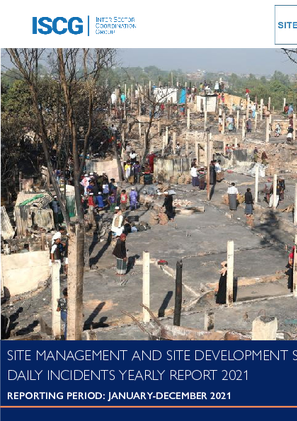-
Countries
-
Data and Analysis
-
Special Focus
-
Crisis Responses
Bangladesh — Site Management and Site Development Sector Daily Incidents Yearly Report 2021 (January -December 2021)

Contacto
NPM Bangladesh, npmbangladesh@iom.int
Idioma
English
Ubicación
Bangladesh
Fecha de instantánea
Jan 01 2021
Dec 31 2021
Actividad
- Other
Introduction Following the military crackdown in August 2017 in Rakhine State, Myanmar, an estimated 700,000 Rohingya refugees fled to Cox’s Bazar district, Bangladesh. Previous influxes were recorded in October 2016, when approximately 87,000 people crossed into Bangladesh, and other waves were registered during the previous decades. The total number of Rohingya refugees in Cox’s Bazar, including those residing in the district prior to August 2017 is estimated to be 925,380 individuals .
The Rohingya refugee population is concentrated in extremely congested sites within Ukhiya and Teknaf Upazilas of Cox’s Bazar district which is well known to be vulnerable due to annual monsoon and cyclone seasons. Most of the shelters where the refugees live are made of tarpaulin sheets and bamboo in areas that are either hilly or low-lying. The combination of densely populated sites and unsustainable shelter material exposes the refugee population to serious risks associated with heavy rains and high winds, such as flooding and landslides.
The Site Management Site Development Sector (SMSD) Daily Incident Report (formerly known as the SM Category 1 Daily Incident Report) was established in May 2018 to support the Rohingya refugee response during the cyclone and monsoon season. This system was developed by the SMSD Sector in coordination with the Inter Sector Coordination Group (ISCG), IOM and UNHCR. Through this assessments, Site Management Support (SMS) Agencies systematically collect information across all camps in Cox’s Bazar affected by small-scale weather related incidents. The incidents captured through this mechanism refer to small-scale localized events (such as landslides, flood, windstorm) that cause minor to moderate damage and have little to no impact outside of the locally affected area. In case of Level 2 or 3 events2 , of larger scope, the ISCG would trigger a JNA and the SMSD Daily Incident Reporting exercise would be suspended. The purpose of the system is to track any daily incidents across all camps, and their impact on the affected population.
